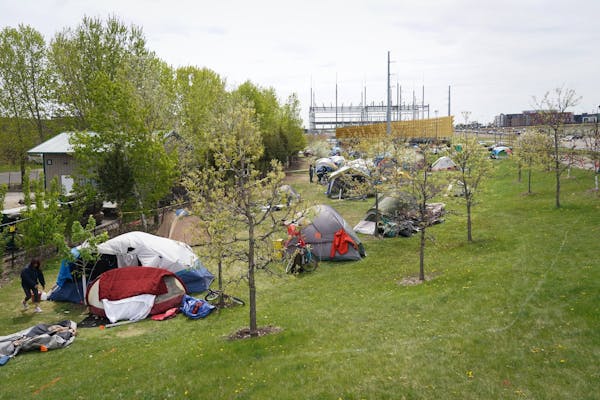The Metropolitan Council began clearing a large homeless encampment along Hiawatha Avenue in south Minneapolis Thursday as a building still smoldered from overnight fires a few blocks away.
The encampment, which formed in April, was too close for safety to the epicenter of last night's protests over the death of George Floyd, said Terri Dresen, a spokeswoman for the Met Council, which controls the property.
Those protests erupted in arson and looting up and down Lake Street, just two blocks to the south.
"This is for the safety of everyone in the encampment," Dresen said.
What started with just a few people a little more than a month ago, quickly grew to a small neighborhood with more than 70 tents on a grassy right of way near the corner of Hiawatha Avenue and 28th Street. The early inhabitants of the site dubbed it "Camp Quarantine," and said they moved there largely to avoid the pandemic as libraries and other public buildings shut their doors, leaving homeless people with nowhere to go during the day.
In an attempt to contain the site and discourage its growth, Metro Transit authorities put a fence around the tents early this month. They estimated that fewer than 100 people were living on the site by the time they began to clear it.
Dresen said the Met Council will try to find temporary shelter for everyone who had been there. Metro Transit police officers collected lists of names as people packed their tents and belongings, saying they would try to find them hotel rooms, dorm rooms or other places to stay.
As the tightly packed tents began to clear, trash remained scattered on the grass — garbage bags and containers, half-filled bottles and residue-caked pipes.
Volunteers brought packs of water and handed out brown lunch bags and hand sanitizer.
Jamie Tiessen, who had been living at the camp for about three weeks, said she was trying to get on the shelter list.
"Hopefully, I'll be able to get help and get in some place," she said.
Tiessen said even with people living so close together during the pandemic, and with the protests reaching so near the camp, that she felt "safe enough."
"I'd feel better if people would've cleaned their [stuff] a little more."
Roger Dale Thompson, 22, said he wasn't sure what he was going to do. It was his first time in a crowded camp and he had his tent set up right on the edge, a few quick feet from the exit. He said he'd rather stay there than go back to bouncing between alleys, empty side streets and parks. He was born in St. Paul, and still has family in the area, but, he said, they don't talk.
Thompson said he understood why authorities would think the site has become a hazard, but reiterated that he didn't think it had become unsafe.
"They're just trying to do their jobs," he said. "But I feel safe here."
Several advocacy and outreach groups have been calling on local and state officials for more than a month to find safer sheltering sites for those in the camp.
It's frustrating that little was done before the protests erupted nearby, said John Tribbett, program manager for the St. Stephen's Street Outreach team.
"It's unfortunate that finding single unit sheltering sites didn't take place months ago," he said. "But while we're frustrated, we're glad that the resources have been put in place now and that there's a plan. It's not merely a matter of telling people to leave who have nowhere to go."

Want to share info with the Star Tribune? How to do it securely

'Safe recovery sites' would offer syringes, naloxone and more to people using drugs. The plan could be in peril.
New Minnesota GOP leaders seek peace with party's anti-establishment wing

Who is Republican Lisa Demuth, Minnesota's first House speaker of color?

